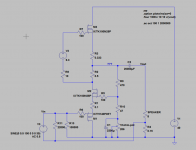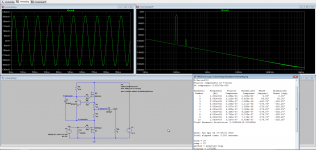
I built this little amp to evaluate the P channel buffer working at a low Vds = Vgs (-4,7 volts) and at the same time get some hands on quality time with a simple Mu follower modulated current source.
The mosfets in the sim is not the same as I use in my amp. They are what I consider reasonably near.
M1 is an Ixys IXTP32P05T and M2 is an IRF3706 in the real amp playing in the background as I write this.
I am astonished at the sound quality coming out of this very simple little amp.
I guess I get a watt or soo, which is enough with a large BIB and a high efficient 10 inch pro driver.
I am going to build a PCF Zen amp (soon), but I often find my self just listening to music without any need of any other amp...
Cheers,
Johnnes
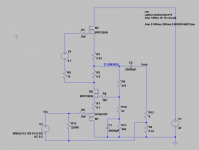
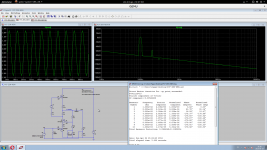
After playing around with this circuit in LTSpice and IRL, and after spending some quality time working with it in my head while drinking tea and listening to Skinny Puppy and Ahmad Jamal (among many other musicians) I finally arrived here.
This is kind of semi-final product. Yes there is some second harmonic content. There might be ways to lower the THD if that is the goal (which it isn't for me) . I prefer a slight touch of second harmonic since this comes from the Schaded fet main gain device and the positive current feedback superimposing the character of the Schade-feedback back upon the gain-device again. This will make the amp sound much more similar to a triod. It is "SIT-ified" like the transformer-Schade-feedback amp Nelson Pass presents at BAF-2015.
With a 0,15 ohm R-sense the amp seems to have a very slight negative output impedance in simulation. I guesstimate that combined with the resistance in cables, the coupling capacitor on the output etc it will have a load-invariant almost infinite damping-factor. This is easy to adjust by changing the value of R4. 0,22 ohm R4 (R-sense) will give a pronounced negative output impedance in simulation. It is quite device-dependent.
I have not built this exact amp yet. I will not use the IRFP250 and the bottom P-channel fet is not a Si7461DP. As in any Zen-amp there is a considerable leeway in the choice of gain-devices. I will use IXYS IXTH140P05T2 for the bottom P-channel fet and IXTK100N25P for the N-channel devices. I am actually considering battery-bias for the MU-follower dynamic current-source. It seems like a neat and simple way to build a MU-follower. I am not very stressed by changing batteries once every 2 or 5 years or so.
It seems to work like a charm in simulation at least.
Cheers,
Johannes
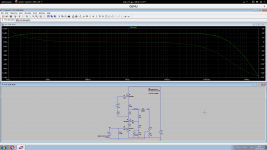
Fast enough for audio. 3 dB down at 220 khz. No strange phase-shifts or resonant tendencies (at least with a pure resistive load in simulation - I wish it was this simple and predictable in real life).
Yesterday I wrote that there is a considerable leeway in the choice of gain-devices. I only want to stress that the P-channel fet is quite important. I would not use a weak device like IRFP9240/9140, IRF9530/9540 or similar. Weak, high voltage, low current, low transconductance devices sound very dull and boring in this kind of circuit. The amp is quite heavily taxed by not only having to amplify a small signal and drive a heavy reactive low impedance load, but now doing it with lots of control and "muscle" in controlling the aforementioned heavy reactive load with a very low output impedance.
I have found that a low voltage, high current, high transconductance device like the IXYS IXTH140P05T sounds much better with much less distortion in this amp.
I guess an (or several paralleled) IRF4905 could be a good alternative from IR.
I would love to parallel 10 pieces of IRF7410 -12 volt P-channel devices. It is a shame there is no -12 volt (Vds) devices in TO247 packages.
http://www.irf.com/product-info/datasheets/data/irf7410pbf.pdf
If anyone wonders why I want to use such low voltage devices then I want to refer to Nelson Pass most excellent article Zen Amp Redux http://www.firstwatt.com/pdf/art_zen_redux.pdf
Cheers,
Johannes
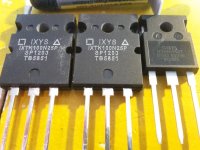
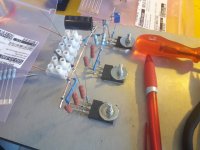
I widened the mounting holes to 4,1 mm. I want to use 4 mm bolts through the 15 mm aluminum plate that I use as a heatsink.
It is a spacious point to point build. It makes it easy to swap parts when trying out new ideas.
I wish I could make nice looking PCBs, but that will have to be another time.
Now I just want to hear this amp play. It has been a long project. I have built a lot of variations, and tested the sub-circuits as stand alone amplifiers.
My experience with the IXYS devices soo far makes me want to burn the IR parts to ash with a 10 kA blast-furnace heater. The IXYS parts sound much much better in every way.
There is really no comparison.
I am curious as to what an IRFP7430 can do. They seem quite odd but in a good way.
Cheers,
Johannes
Thanks Edwin and Tord Nilsson for kind words!
I am listening to this amp as I write, and I will try to restrain my enthusiasm somewhat in a futile attempt to keep my credibility reasonably intact.
I am back to the effortless presentation of timbre and dynamics I heard with the first PCF-Zen amp I built with an IRLB3813. This time it is much much better though. I am playing everything from Angry Kore, Deep Chord, Skrillex, via Ahmad Jamal, Art Blakey and John Coltrane to Eva Cassidy and Skinny Puppy thrown into the mix. Everything is very alive with a natural effortless timbre. The bass is vigorous and energetic without any hint of bloat or fuzziness. Just clean with a very short, sharp hard start and stop. No bloom or overshoot.
The amp does not sound like a typical single stage class A amp in that it has a much better control and much more "muscle" then any simple class A amps I have ever heard before. The presence and the clean effortless representation is there. It does not sound like a typical pushpull class A/B amp either.
I want to shout out to everyone here "please build this amp now!!!" but I know it is not nice to shout loudly (all caps) in a forum...
The "blast furnace - burn IR fets to ash" statement I made in a previous post is of course an unduly excessive statement since I know they can sound wonderful in simple class A amps, but I hope you all can understand my statement as a utterance of my desire to emphasize the quite dramatic difference in sound quality obtainable with IXYS Polar series mosfets compared to the standard IRFP-044-140-150-240-250 series from IR.
Once you get past the problem of driving the quite large capacitance of these very powerful devices they can really deliver....
I wish Nelson Pass would present this idea as an article in his Zen series of single stage class A amps, since I know it would get the attention it really deserves by coming from someone known and respected and not only from some eccentric unknown Swedish guy.
I don't have the knowledge or the resources to make a nice article with measurements, nice graphs and printed circuit boards. I only have my ideas and I love to tinker with electronics and explore different technologies (like PCF).
I hope somebody musters up the courage needed to devote some time and money in a project presented by some unknown Swedish eccentric guy.
Till then I will happily listen to my unique currently single channel PCF-Zen-amp with a big smile in my face, admiring myself and my smug elitist feeling of having something unique no one else has. 😀
Cheers,
Johannes
I am listening to this amp as I write, and I will try to restrain my enthusiasm somewhat in a futile attempt to keep my credibility reasonably intact.
I am back to the effortless presentation of timbre and dynamics I heard with the first PCF-Zen amp I built with an IRLB3813. This time it is much much better though. I am playing everything from Angry Kore, Deep Chord, Skrillex, via Ahmad Jamal, Art Blakey and John Coltrane to Eva Cassidy and Skinny Puppy thrown into the mix. Everything is very alive with a natural effortless timbre. The bass is vigorous and energetic without any hint of bloat or fuzziness. Just clean with a very short, sharp hard start and stop. No bloom or overshoot.
The amp does not sound like a typical single stage class A amp in that it has a much better control and much more "muscle" then any simple class A amps I have ever heard before. The presence and the clean effortless representation is there. It does not sound like a typical pushpull class A/B amp either.
I want to shout out to everyone here "please build this amp now!!!" but I know it is not nice to shout loudly (all caps) in a forum...
The "blast furnace - burn IR fets to ash" statement I made in a previous post is of course an unduly excessive statement since I know they can sound wonderful in simple class A amps, but I hope you all can understand my statement as a utterance of my desire to emphasize the quite dramatic difference in sound quality obtainable with IXYS Polar series mosfets compared to the standard IRFP-044-140-150-240-250 series from IR.
Once you get past the problem of driving the quite large capacitance of these very powerful devices they can really deliver....
I wish Nelson Pass would present this idea as an article in his Zen series of single stage class A amps, since I know it would get the attention it really deserves by coming from someone known and respected and not only from some eccentric unknown Swedish guy.
I don't have the knowledge or the resources to make a nice article with measurements, nice graphs and printed circuit boards. I only have my ideas and I love to tinker with electronics and explore different technologies (like PCF).
I hope somebody musters up the courage needed to devote some time and money in a project presented by some unknown Swedish eccentric guy.
Till then I will happily listen to my unique currently single channel PCF-Zen-amp with a big smile in my face, admiring myself and my smug elitist feeling of having something unique no one else has. 😀

Cheers,
Johannes
This is what is so nice about this forum, guys that experiment with new ideas like you.
A printable schematic without the graph would be nice Circlomanen.
A printable schematic without the graph would be nice Circlomanen.
Last edited:
"I want to shout out to everyone here "please build this amp now!!!" but I know it is not nice to shout loudly (all caps) in a forum..."
Well I think it is time to order some parts and get down in the basement for some serious work...!
I love this development of unorthodxox things !
Pardon for my bad engliszchzz...
/ Tord
Well I think it is time to order some parts and get down in the basement for some serious work...!
I love this development of unorthodxox things !
Pardon for my bad engliszchzz...
/ Tord
Hmm I bought stuff for your last build..havent had time to try it yet,now this that is supposed to sound better huhhhh..😉
will it work with 5v to?I am using a lab power supply as voltage reference for the MU-Follower (6,3 volts V2.
will it work with 5v to?
The IXYS IXTK100N25P has about 5,2 - 5,4 volts Vgs for 1,5 amps of current. You need at least the Vgs of the device at the current you are going to run plus a few tenths of a volt to use as a voltage reference over the resistors.
I would recommend a standard MU-follower (SRPP) current source with a small BC546-547B or similar small signal transistor as a voltage-reference like Nelson Pass uses in the Amp Camp Amp. http://www.firstwatt.com/pdf/art_amp_camp_1.pdf
You can use a battery or even a small (lab) power-supply as a voltage reference, but it is much easier to use a small transistor.
I can post an updated schematic if you want to.
Since these amps are so simple and forgiving of layout, different parts etc, I am deliberately vague. People should use what they have and what suits them. I can't design a perfect amp for everybody. I am no engineer. I want to post my ideas to inspire other people and to share my ideas. Not as a complete and finished amp.
Some people might prefer a single IRFP240 or ten IRF3711 paralleled, and neither alternative is wrong or worse then the other. It is just a way to voice your amp differently.
Since no amp is perfect, it is much better to built what you like and prefer, or at least experiment with different ideas to find out what you like and prefer.
I bought stuff for your last build
What parts did you buy? If you post the parts you bought I can hopefully design something based on those that is more resembling this last amp I built.
This is an adventure. I learn as a go, and consequently my design evolves over time. I don't have a reference design. I would gladly build this last amp with IRLB3813 or IRFP7430 if I had more of those mosfets lying around.
I got a good deal on the IXTK100N25P from Elfa, this is why I suddenly use them instead.
I have been wanting to test the IXYS devices for a long time, and when they made me an offer I could not refuse........
Cheers,
Johannes
Yes.I can post an updated schematic if you want to.
What parts did you buy? If you post the parts you bought I can hopefully design something based on those that is more resembling this last amp I built.
It was parts for this scema:
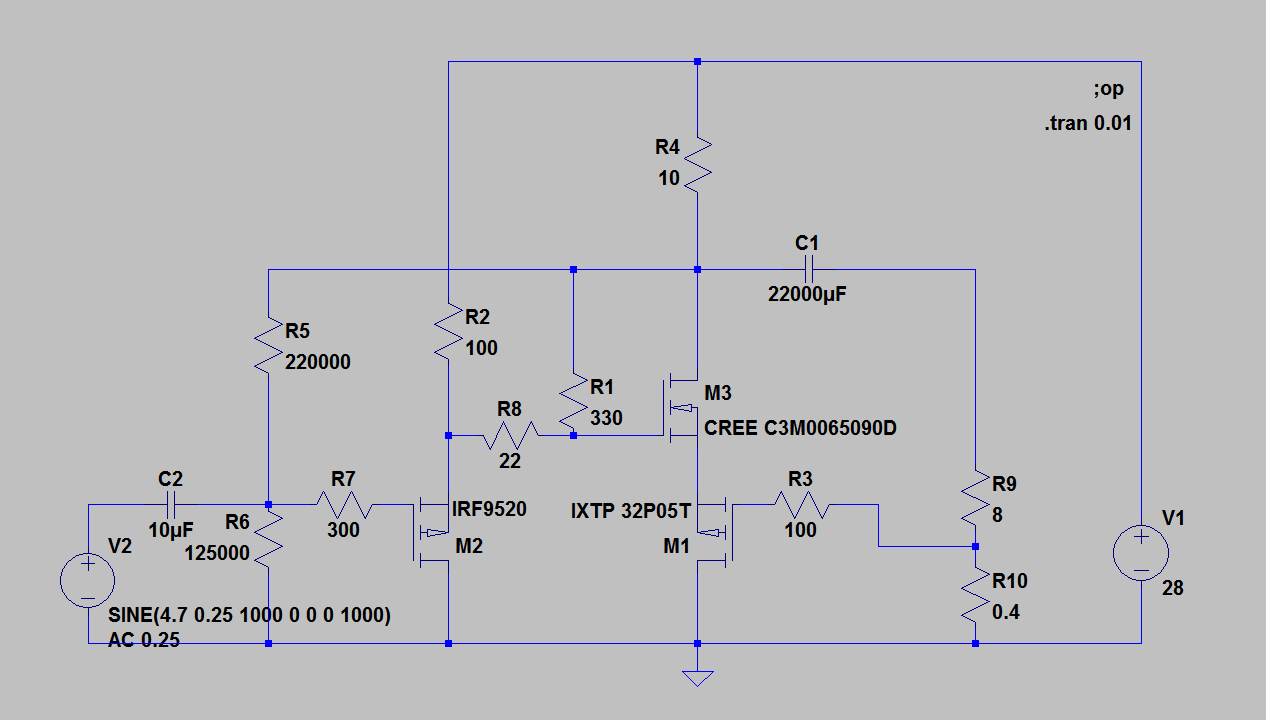
And the Nelson pass CCS,I guess it wouldnt be to expensive to buy parts for your new design,but if you have the time and "ork" to write the schema.. 🙂
According to the advertising on the front of the package I should not need to change bias-batteries until July 2032.
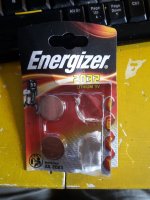
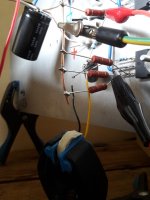
A really ugly point to point test amp. I use a small clamp to hold the two 3 volt batteries together and to attach the small leads. Ugly but efficient and easy to build. Battery bias works perfectly. I can't hear any extra noise compared to the lab power supply I used yesterday. There might be some, but if it where a problem it would be easy to filter the noise with some small polypropylene capacitors. I use a 1000 uF electrolytic capacitor over the battery, and I guess it filters away any noise very efficiently.
I am very tired today. I will look into this later this evening or tomorrow.
Cheers,
Johannes


A really ugly point to point test amp. I use a small clamp to hold the two 3 volt batteries together and to attach the small leads. Ugly but efficient and easy to build. Battery bias works perfectly. I can't hear any extra noise compared to the lab power supply I used yesterday. There might be some, but if it where a problem it would be easy to filter the noise with some small polypropylene capacitors. I use a 1000 uF electrolytic capacitor over the battery, and I guess it filters away any noise very efficiently.
but if you have the time and "ork" to write the schema
I am very tired today. I will look into this later this evening or tomorrow.
Cheers,
Johannes
Hello Johannes,
I am interested to try the amp with IRF 240 and 9240 as i have several of these leftovers from the F5 built. I hope to recycle the 0-18, 0-18 Vac transformer.
Is it feasible to get a clean 10 W ?
thanks for sharing.
kp93300
I am interested to try the amp with IRF 240 and 9240 as i have several of these leftovers from the F5 built. I hope to recycle the 0-18, 0-18 Vac transformer.
Is it feasible to get a clean 10 W ?
thanks for sharing.
kp93300
,but if you have the time and "ork" to write the schema
I am interested to try the amp with IRF 240 and 9240
I will answer both of you with the same post, since they are quite similar.
I would not use IRFP9240 as the bottom P-channel fet.
With an IRF4905, IXYS IXTP32P05T or other similar low voltage high power P channel device the distortion drops substantially compared to the IRFP9240.
The Cree seems quite weak at low voltages so I guess it will behave somewhat similar to an IRFP240. Remember that the simple single stage amp is quite taxed by having to both provide lots of voltage gain and current gain and on top of this it has to control a highly reactive load with a very low output impedance.
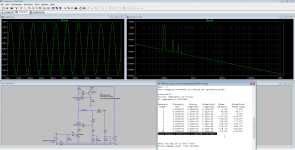
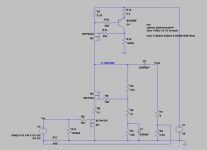
(R3 should be a 1 kohm trim pot since this sets the operating point of the amp)
Here is a simulation with the IRFP240 and a standard Zen constant current source as in Nelson Pass original Zen article.
There is more distortion then I can accept. I can not really recommend this amp with PCF and the IRFP240.
With the Cree you need at least 50 volts power supply and 2 paralleled Cree SiC fets if you want to use PCF without to much distortion.
I like the Cree parts, but I can't get the performance I want from them at these low voltages. They sound marvelous as long as you don't demand to much from them though.
I am quite surprised by this as I bought several of them for this exact project.
Please built this amp as simulated above if you really want to try and you already have the parts (with either the IRFP240 or the Cree SiC fet), but be warned that it might not perform satisfactorily.
The IRFP9140 did not sound very good in a similar amp with PCF. At very low amounts of PCF it did sound quite nice, but did not provide a very high damping factor. The IXYS 32P05T is much better, and the IXYS 140P05T is a monster (in a good way).
If you want to increase the damping factor and lower distortion the Aleph current source or a MU follower is much better then a standard CSS.
Cheers,
Johannes
Last edited:
Johannas,
Thanks for the reply.
What is the circuit of the amp your build while listening to amp described in post 108?
I will try to get the mosfet from ebay .
thanks
kp93300
Thanks for the reply.
What is the circuit of the amp your build while listening to amp described in post 108?
I will try to get the mosfet from ebay .
thanks
kp93300
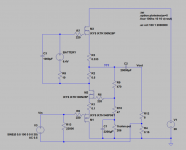
This is what I listened to and described in post 108.
R4 (R-sense) is actually 0,14066 ohm (0,22 and 0,39 ohm parallel). I did not have a 0,15 ohm power resistor at home. I would like to lower this resistor value to 0,1 - 0,12 ohm, since when the amp heats up the output impedance becomes slightly negative and the distortion increases somewhat. There is a very special sonic character associated with a negative output impedance. This is an area where you might need to experiment a little to make the amp suit your speakers, listening room and taste. A very small change of the R4 can make the amp sound very different. When I touch a small 1 ohm resistor across R4 (to lower the positive current feedback) the amp seems to "relax" a bit. It sounds much better when still cold or with a slightly lower R4 value.
M2 and M3 could be almost any 40+ volt Vds device from IXYS with a suitable low thermal resistance and high transconductance. I guess (but have not tried myself) an IRFP044 - 054 - 064 or similar quite powerful high transconductance part could work.
My first choice would be a large "hockeypuck" SOT-227 IXFN300N10P device, but they are quite expensive.
Cheers,
Johannes
View attachment PCF-ZEN-NEW.asc
Here is the spice file if anyone wants to play with it in LTSpice.
Cheers,
Johannes
Here is the spice file if anyone wants to play with it in LTSpice.
Cheers,
Johannes
- Home
- Amplifiers
- Pass Labs
- Positive Current Feedback simple Zen amp

